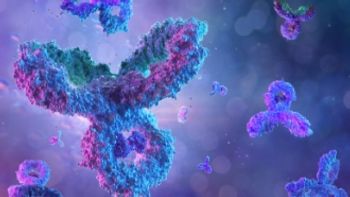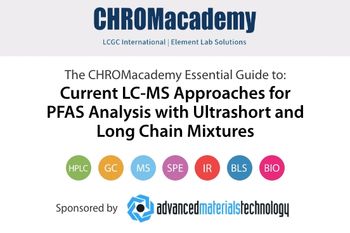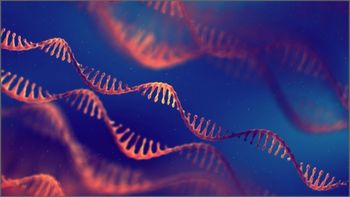
ChromSoc (U)HPLC Virtual Symposium: A Tribute To John Knox
*Tuesday, June 1, 2021 at 12:30pm BST| 1:30pm CEST| 7:30am EDT & Wednesday, June 2, 2021 at 12:30pm BST| 1:30pm CEST| 7:30am EDT* John Knox played a pivotal role in the evolution and understanding of both gas and liquid chromatography and is perhaps best known for the development of the Knox Equation, which describes the different contributions to overall band broadening of a solute. *On Demand June 2, 2021*
Register Free:
Event Overview:
John Knox played a pivotal role in the evolution and understanding of both gas and liquid chromatography and is perhaps best known for the development of the Knox Equation, which describes the different contributions to overall band broadening of a solute.
This two-day virtual event celebrates the life and work of John Knox with an emphasis on modern liquid chromatography. This virtual symposium has been organized by The Chromatographic Society (“ChromSoc”) in collaboration with LCGC. Join us to learn about important fundamental aspects and practical applications of (U)HPLC from key practitioners in the field. Following the seminars there will be an opportunity to ask the experts your questions when they all come together for a live question-and-answer (Q&A) session . The event will include a short presentation about how joining ChromSoc can help to enhance your knowledge and skills in separation science. Leading chromatography companies will also provide insights about liquid chromatography separations in short presentations throughout the day. In particular, by joining this event, you will:
- Learn about the latest developments in fundamental aspects of (U)HPLC
- Discover the latest analytical (U)HPLC approaches used in key application areas, including clinical analysis and anti-doping
- Hear talks from the family of John Knox and scientists who have worked under his tutelage on his life and work
- Discover the array of benefits available to members of the Chromatographic Society (ChromSoc)
- Ask the experts questions on their presentations in a live Q&A session at the end of each day.
Key Learning Objectives:
- The value of improving knowledge on the fundamentals of LC
- Developments in cutting-edge applications using LC
- Benefits of joining The Chromatographic Society (ChromSoc)
- The importance of John Knox’s contribution to chromatography
- Insights on (U)HPLC from leading chromatography companies
Schedule:
Day 1: (U)HPLC: Fundamental Aspects of (U)HPLC
12:30 – 12:45:
Introduction and Welcome from The Chromatographic Society
Anthony Edge, ChromSoc, UK
Tony Edge, ChromSoc President, describes the on-going importance of the work of John Knox for chromatographers and the benefits of joining The Chromatographic Society (ChromSoc)
12:45 – 1:00:
Life & Times – A Dedication to John Knox
1:00 – 1:45:
Dispersion Modeling in Liquid Chromatography: Classic and New Views
Gert Desmet, Vrije Universiteit Brussel (VUB), Belgium
The band broadening processes that occur in liquid chromatography are very complex. Due to the combined effort of many great scientists building upon each other's work in the past decades, the most important parts of the puzzle have now been solved. To date this has produced a relatively clear picture of the different individual band broadening contributions, how they are linked together, and how they can be used to qualitatively explain most of the experimental facts and findings. Despite the many achievements made in the past, there are, however, still a number of important and intriguing questions that remain: Is there a direct link between particle size distribution and column efficiency? Is there a possibility to quantitatively relate the values of the A, B, and C-term to the bed structure? How does radial dispersion exactly contribute to the observed eddy-dispersion? Many of these questions still await a definitive answer and can only be answered using sophisticated modelling of the fine details of the column. An update on the most recent findings of this work will be presented.
1:45 – 2:00:
When is bigger better? Considerations and Applications for Scaling from Analytical to (Semi-) Preparative Chromatography
Philip Hoang, Technical Marketing Specialist - Analytical Chromatography, Tosoh Bioscience LLC
Advancements in chromatography have largely been in analytical applications, including smaller particle sizes and column geometries. While these are the first choice for applications such as identification and characterization, they can also be limiting when purification and fractionation are needed. Here, larger semi-preparative and preparative chromatography columns are a better fit as they provide higher loading capacities and larger yields. They also include the added utility where higher amounts of material can be collected for in-depth analysis by secondary orthogonal techniques such as mass spectrometry. Challenges in semi-preparative chromatography are in column selection, choosing optimal loading capacities, and other method parameters such as flow rate while still being able to maintain performance comparable to their analytical counterpart. Here guidance is provided in how to scale from analytical to semi-preparative chromatography for the purpose of purification and isolation as well as presentation of a novel workflow for the analysis of isolated monoclonal antibody (mAbs) from semi-preparative FcR-IIIA affinity chromatography by analytical HILIC mass spectrometry.
2:00 – 2:45:
Longitudinal Diffusion in Chromatography
Fabrice Gritti, Waters Corporation, USA
This presentation explores the definition, the underlying physical meaning, and the impact of natural longitudinal diffusion of the analyte molecules along a chromatographic column. The important role played by John Knox on the derivation of the first models of longitudinal diffusion and the early experimental technique to measure the rate at which the analyte zone spreads along either empty or packed gas chromatography column at a zero-flow velocity are remembered. From there, we elaborate on the on-going experimental and theoretical development underlying the quantification of the so-called “B term” in the general van Deemter equation in liquid chromatography, its impact on column performance, and on its overall practical relevance in separation science.
2:45 – 3:00:
Sponsor Session
3:00 – 3:45:
Improved Methodologies for the Measurement and Modelling of
Intra-particle Diffusion in Reversed-phase Liquid Chromatography
Deirdre Cabooter, KU Leven, Leuven, Belgium
To better understand the underlying mechanisms of band broadening in reversed-phase liquid chromatography columns, new models for intra-particle diffusion are proposed. In these models, it is assumed that the mesoporous zone inside the particles can be subdivided in four fractions: fraction f1 containing a bulk mobile phase, fraction f2 enriched with pure organic modifier that extends outside the stationary phase layer, fraction f3 composed of the liquid surrounding the alkyl chains, and fraction f4 consisting of the alkyl chains. Intra-particle diffusion is then calculated as a residence time weighted average of the diffusion in these different fractions. Experimental procedures and models are proposed to determine the volumes of these four regions and applied to different RPLC columns with different pore sizes (80 Å versus 300 Å) and different stationary phase types (C18 versus C8). The new models are then used to determine the intra-particle diffusion of a neutral test compound (butyrophenone) for a range of retention factors in these columns. The predictions are compared to experimental data that are extracted from the effective diffusion coefficients of butyrophenone obtained via peak parking experiments. It is demonstrated that the proposed models for intra-particle diffusion model the actual behavior of butyrophenone well and that surface diffusion plays an important role in the mass transfer of retained compounds in reversed-phase LC columns.
3:45 – 4:00:
Sponsor Session
4:00 – 4:30:
Question & Answer Session
Day 2: Practical Aspects of (U)HPLC
12:30 – 12:45:
Introduction and Welcome from The Chromatographic Society
Anthony Edge, ChromSoc, United Kingdom
12:45 – 1:00:
The Adventures of John Knox
John Knox Family Members: Catriona Graham, David Knox, Jonathon Knox
Professor Knox was father to four sons and grandfather to twelve. An avid kayaker, sailor, and inventor he inspired a thirst for adventure in all his family. Here his sons and grandchildren tell of John’s intrepid experiments and outdoor expeditions from the family perspective.
1:00 – 1:45:
Opportunities for Ultra-rapid LC–MS/MS in High-throughput Bioanalysis
Dr Lewis Couchman, Analytical Services International Ltd., St. George’s – University of London, London, UK
Typically, targeted quantitative LC-MS/MS analyses using gradient elution are carried out at the rate of a few minutes per injection. In this paper, an approach for ultra-rapid LC-MS/MS analysis will be described in which complete injection-to-injection cycle-times are just 30 seconds, equating to at least one 96-well plate per hour. These cycle times are more akin to those of direct injection methods such as flow-injection analysis, but despite this include efficient chromatographic separation of target analytes. This enables (i) the removal of interference from isobaric compounds, for example, from other drugs and/or metabolites) and also (ii) the reduction of ionization effects caused by co-eluting matrix components. In this presentation, application of the approach will be demonstrated using examples from therapeutic drug monitoring and clinical and forensic toxicology. The practical considerations for implementation of the approach to dramatically speed up other analyses will be discussed.
1:45 – 2:00:
Sponsor Session
2:00 – 2:45:
Chromatography and Mass Spectrometry – Orthogonal Bedfellows in
Anti-doping Analysis?
David Cowan, Kings College, London, UK
The mass spectrometer is able to provide valuable analytical information without the need for a chromatograph whereas the chromatograph needs a detector to be of use. Indeed, many scientists, working with the most advanced mass spectrometers such as in the area now branded as “petroleomics”, are able to identify large numbers of individual analytes in a mixture without the need for chromatographic separation. In the field of ambient ionisation mass spectrometry, the absence of a chromatographic front-end is considered a desirable feature avoiding sample preparation and offering rapid sample analysis. This range of ionisation techniques are starting to show much promise in areas of controlling drug misuse, such as identifying new psychoactive substances many of which are also prohibited in sport. However, in the field of anti-doping analysis, it is not currently realistic to use a mass spectrometer without a chromatograph and the field actually benefits from the synergy provided by combining both techniques. This presentation aims to illustrate how modern chromatography and chromatography coupled with mass spectrometry benefits anti-doping scientists in their efforts to help control drug misuse in sport.
2:45 – 3:00:
Sponsor Session
3:00 – 3:45:
Forget About Chromatography and Move Into the Future
Peter Myers, University of Liverpool, Liverpool, UK
Take a look at a chromatogram from years ago and compare it to a recent chromatogram. Do you notice any difference? Maybe the formatting is different, but the information is virtually the same. Look at a chromatograph from a few years ago and look at the one you have today. Notice any difference? The instrument will look virtually the same. The most significant thing that has changed in the last 20 years is in the reduction of particle size in HPLC. Has chromatography hit a dead end? In this illuminating talk which aims to stimulate debate, Peter Myers explores this theme and offers insights into how chromatography could possibly evolve, including the benefits that pattern recognition systems could provide.
3:45 – 4:00:
Sponsor Session
4:00 – 4:30:
Question & Answer Session
Times and Dates:
Tuesday, June 1, 2021 at 12:30pm BST| 1:30pm CEST| 7:30am EDT
Wednesday, June 2, 2021 at 12:30pm BST| 1:30pm CEST| 7:30am EDT
Register free:
Newsletter
Join the global community of analytical scientists who trust LCGC for insights on the latest techniques, trends, and expert solutions in chromatography.





